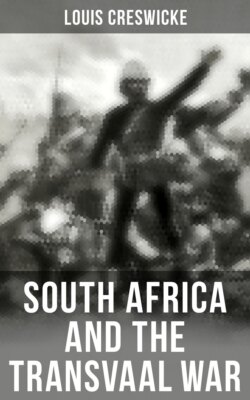Читать книгу South Africa and the Transvaal War - Louis Creswicke - Страница 84
На сайте Литреса книга снята с продажи.
ESTCOURT
ОглавлениеTable of Contents
Opinions regarding Estcourt differ. Some consider it a picturesque and verdant little village, placed in the bosom of the hills and very similar to a Sussex hamlet on the Downs. Others have described it as well deserving the name of being the hottest and most unpleasant region in the high veldt of Natal. It is in the thorn country, and is surrounded with rough irregular kopjes. The railway bridge over the Bushman's River is an imposing structure, and the line leads from Durban to Maritzburg, Colenso, and Ladysmith, and thence to the Orange Free State and the Transvaal. A little lower down the river is a substantial bridge that runs across from Estcourt to Fort Napier, a quaint-looking structure, neither ornamental nor useful, for hills behind and round it command the situation. Thus commanded, it is utterly indefensible, and would need an army corps to hold it. The garrison, under Brigadier-General Wolfe-Murray, at this time consisted of the Royal Dublin Fusiliers, the Border Regiment, one squadron of Imperial Light Horse, Natal Field Artillery, and some scouts. This small force would have been absolutely inadequate to the defence of the place had it been seriously attacked. The Boers in hordes were supported at Colenso by heavy guns, while the British troops that had to evacuate that village had but one obsolete nine-pounder manned by volunteers. The absence of good guns was everywhere deplored. At Ladysmith the position was merely saved by the hasty arrival at the very last moment of the Naval Brigade with their formidable weapons, and at Colenso the regrettable evacuation was obligatory solely on account of the lack of guns. The depressing effect of retreat on the unhappy colonists who had their homes in the neighbourhood may be imagined.
From Estcourt on a clear day, with a northerly wind blowing, the exciting sound of hostilities in the neighbourhood of Ladysmith was distinctly to be heard, the deep bass of "Long Tom" booming upon the air, while the heavy baritone of the 4.7 Naval guns kept up the diabolical duet. Intense curiosity as to the doings of the besieged prevailed, but it was impossible to do more than mount up some of the highest hills and look down into the cup of shadow where Ladysmith was known to be. In that direction the hollow presented the air of an active volcano, volumes of smoke floating upwards, and spreading their message of bombardment and resistance far and wide. But nothing active could be done. The tiny garrison, it was true, was receiving reinforcements, but these came in by driblets. General Wolfe-Murray engaged himself in planning defences which should at all events make Estcourt into a hard nut to crack, and caused redoubts and intrenchments to be constructed so that the place might be safe against such attack as the Boers would make. The troops were kept in excellent training, to ensure their fitness to take the field at a moment's notice.
On the 9th of November there was general satisfaction owing to the safe arrival, under a flag of truce, of ninety-eight wounded from Dundee. The officers among them were Colonel Beckett of the Natal Field Force, Major Hammersley, Lancashire Fusiliers; Captain Adam, A.D.C.; Captain M'Lachlan, Major Boultbee, King's Royal Rifles; Lieutenant C. N. Perreau, Captain Dibly, Dublin Fusiliers; and Lieutenant B. de W. Weldon of the Leicesters. There was also some grim rejoicing in hearing reports that were brought in that the Boers in their attack on Ladysmith had suffered severely, and that Bester's Farm, to meet the strain, had been turned by them into a hospital. The first detachment of the long-looked-for division was now expected, and every one in camp began already to think the siege of Ladysmith might be considered a thing of the past.
Nothing warlike took place for some days. On the 14th, however, at noon, the sound of three guns gave evidence that parties of the enemy had somewhere made their appearance. The garrison—now counting the West Yorks—numbering some 3000 men, stood to arms. Colonel Martyn, in command of the mounted troops, at once started off in the direction whence a crackling of musketry proceeded. The Boers, in some force, were located on the summit of a hill firing at our scouts, who quickly retired. Two guns of the Natal Field Artillery were at once sent for, but their arrival was a signal for the enemy to beat a hasty retreat. Their retirement was merely momentary, however, for they went along a chain of hills, and appeared again on another eminence in full force. A squadron of the Natal Carabineers attempted to turn their flank for the purpose of ascertaining their strength, and in so doing estimated their numbers at about 500; any effort to dislodge so large a party would therefore have been useless, and Colonel Martyn with his small force was just about to retire to the hills above Estcourt, when the Boers were observed to be on the move. They were evidently preparing to clear off, which they rapidly did, particularly when assisted by a volley from the Natal Carabineers, whose nimble horses clambered up to the crest with marvellous celerity. After this, in default of sufficient cavalry, there was no choice but to retire. Men and horses were absolutely "dead beat." The expedition, with the mounting of the almost impregnable hill, had occupied six hours. This, however, was only an example of the many, almost daily, encounters that were necessary to arrest the enemy in his advance to the south.
